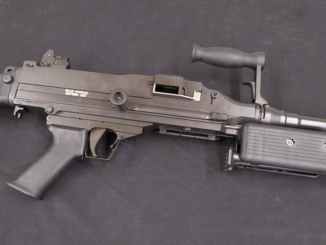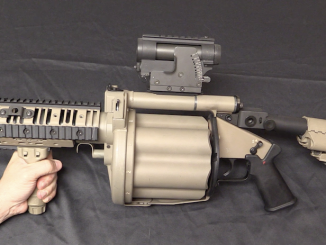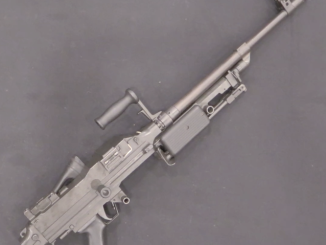Thanks to a friend in South Africa, we have a chance today to take a look at one of the five prototypes of Tommy Steele’s TS V semiauto carbine. This thing is completely ambidextrous (including swappable ejection ports), has an abundance of safety mechanisms, and an integral suppressor complete with massive barrel venting to (in theory) reduce muzzle velocity on standard 115gr 9mm ammunition below the speed of sound.
Steele had begun his military career with the British Royal Marines, before moving to Rhodesia and joining the Rhodesian Army. In 1980 he left the country and emigrated to South Africa, where he joined the SADF, working as an armorer. He began work on this design in the mid 1980s, but the TS V guns were not actually produced until 1996 and 1997 in South Africa. He was unable to find a financial supporter for the design, and thus it never went into series production. All five existing prototypes vary in their details, and this the the first of them.




Oh fiddlesticks, a product without any customers. I suppose police could get it, but would this only serve to terrify people into compliance? “If we really wanted you dead, there would be no protest today. We’d pay each of your houses a visit. There would be a mass funeral the following morning. Forget social media and cellphones, we have radio jamming equipment active and all lines are dead. Nobody will hear you scream.” Thank goodness we don’t live in a fascist police state.
“He was unable to find a financial supporter for the design, and thus it never went into series production”
Speaking honestly this is not surprising for me, as any organization already using some kind of sub-machine gun, would probably be more willing to equip with suppressor, rather than introducing entirely new weapon. Especially considering that for most sub-machine gun, adopting it for used with suppressor is relatively easy task, as most sub-machine gun have fixed (non-moving) barrel.
Me thinks you should enroll in some history classes.
I was joking about the state-sponsored terrorism. There is no American city with police that brutal, right?
As you wrote “fascist”, this lead directly to entity known as Partito Nazionale Fascista and most commonly known political murder connected with it, namely: https://en.wikipedia.org/wiki/Giacomo_Matteotti which was stabbed to death.
Very clever ambidextrous bolt.
“barrel venting to (in theory) reduce muzzle velocity on standard 115gr 9mm ammunition below the speed of sound”
This instantly reminded me about STEN Mk.IIS which also have ported barrel to achieve lower muzzle velocity, according to http://modernfirearms.net/en/submachine-guns/great-britain-submachine-guns/sten-eng/
Contemporary manuals advised that Mk.IIS submachine gun was to be fired in semi-automatic mode; the ful-automatic fire was reserved for emergency situations, as it decreased the service life of silencer significantly.
Which would be another feature close to this one, though mechanically Mk.IIS was still selective-fire.
The H&K MP5SD suppressor was also designed to reduce the MV of normally supersonic ammunition to below Mach 1. And its internal structure was a set of simple, rugged baffles made of thick sheet steel and spotwelded together;
https://www.cncguns.com/images/mp5sd.jpg
It occurs to me that such a sound moderator could be made “in the field” in somebody’s workshop much more easily than most suppressors with multiple internal baffle “cups” and etc.
cheers
eon
Are you sure its made of steel? Don’t look that thick to me.
Also, it looks extremely deceptingly “simple” to make,but I guess its not by far easy job to get all the geometry right.
In mp5sd patents there is a different design, wonder why is that.
Ported barrel with old weight bolt also leads to significantly higher rate of fire, thus degrading the silencer even faster.
As to the effectiveness of the suppressor, (or lack thereof), I suspect that, considering the time period when it was made and the suppression methods utilized, there is a missing or worn out part… The once ubiquitous “End Wipe”… In that era, many suppressors relied on a rubber, neoprene, or oiled leather end wipe, which was an expendable part. As the wipe became shot out, and the exit hole became larger than bullet diameter, efficiency dropped sharply and decibels rose quickly in response. I’ve often speculated, that several suppressed weapons of the age gained the vast majority of their ability to suppress primarily from the end wipe itself, rather than from the rather questionable baffle arrangements. Sionics .22 suppressors and various copies thereof would be a good example of this, as Would Sionics/MAC single and dual stage suppressors. They worked great…until they didn’t. In the US, the BATF rules change that internal suppressor parts are suppressors themselves, brought an end to the long line of Wiped designs that had been proven quite effective until that point. Until the rule change, you could buy replacement suppressor wipes, (and other guts for that matter) through the mail or by the bag at gun shows. Curiously enough, you could also buy tubes, although the same vendor was not allowed to inventory tubes and internals, and possession of both by vendor or individual was considered possession of an unregistered suppressor. I don’t have the data to back it up, but it seems to me that the old wiped designs were quite a bit quieter than “modern” wipeless designs we are left to deal with today. Some companies are returning to a wipe design, with the end wipe not considered to be a user-replaceable part. To replace the wipe, you have to send your unit back to the factory for a rebuild, although these same companies are appealing to the BATF to allow end wipes to be replaced by local FFL gunsmiths instead of the factory.
At one point Cobray sold a threaded 10-.22 barrel with an adapter that allowed you to attach an AR15/M16 standard rifle buffer tube as a suppressor. The only internal part was a end wipe, and the crazy things actually suppressed the rifle pretty well with standard velocity ammo.
Very interesting comment ! Lot to learn from it
I have seen a bolt action .22lr design here in france that used a simple ported 46 cm barrel and a int.dia 26mm tube to silence the gun.
No cartriges are supersonic but it is still guite loud think bb cap.
However attach even the worst and smallest .22 silencer eg still no.3 to the threaded barrel of the gun extending from the tube and you have little or no noise in any case less then a crossman MTR 77NP air rifle in 4.5
Plus its cheap to run no subsonic ammo to buy
You can get much the same result by firing “Long” BB or CB Cap .22 ammunition in a rifle with a 20″ or longer barrel. They are already subsonic, and the powder burn is complete after the bullet has reached the midpoint of the barrel length. The resulting sound signature is about that of a spring-piston air rifle.
cheers
eon
Another truly obscure firearm and an interesting set of design choices.
Are there by any chance some decent photographs of this piece?
Please keep up the great work!
The Chicken
Is it just me, or the gun looks very much alike, especially the grip, paintball marker ?
Small ejection ports could lead to big problems 🙂
Eon actually the rifle I was talking about had only about 23cms of rifling left in the barrel as the last 23cms was reamed out to 6mms
I believe Dr Dater came up with this idea in the 70’s in america so that you needed only one nfa stamp on a silenced rifle as cutting the barrel below 16 inches made it a short barreled rifle thus 2 stamps if silenced
Its good in that you can drill 6.35mm 1/4 inch holes in the reamed area and dont have to worry about deburring the rifling just polish the bore
The rifled section has 3mm holes not hard to deburr just an hour or so with a electric drill cleaning rod and steel wool
In the late of 1979 Rhodesian press wrote: “In the field of small arms the Rhodesians are no less resourceful. Their Army and other organized forces are generally equipped with the FN-FAL or the G-3 automatic rifle. Civilians have had to protect themselves with whatever weapons they have had on hand.
At any social gathering one sees a hodge podge of weapons possessed by the local citizens. Population increases, along with the duration of the current problems, have created quite a demand for additional small arms. Many people attempt to fill this demand, perhaps the best and most reliable being Tommy Steele.
Headquartered on Main Street in Bulawayo, Tommy Steele now produces a weapon that is ideal for the Rhodesian civilian. Chambered for the common 9mm Parabellum cartridge, Mr. Steele’s TS III uses extended length magazines (made by shaping bits of auto bodies over a mandrel) which also work in the Browning 9mm pistol. Barrels and bolts are made by turning and drilling sections of broken, automobile axle, half-shafts. Receivers are made from tubular, structural steel that is shaped on another mandrel while smaller parts are made from spring leaves, gears or whatever other quality bits of steel happen to be handy (see Figure 37). The resulting weapon is a high-quality, fine-looking, reliable 9mm carbine (see Figure 38). Without belaboring the point, it is obvious that Rhodesians consider an efficiency in the use of resources, bordering on parsimony, to be an integral part of their program for self-sufficiency and industrialization. Their economic management board (much like our industrialization boards of World War II) assisted in making machine tools, available to Mr. Steele but forced him to make his weapons from what would be regarded as scrap anywhere else.”
An Uzi could fire without having to pull the trigger? It just had to be dropped? Talk about a time saver! I bet the ARVN could have used those in Vietnam…I hear they dropped their weapons quite frequently…At least if they’d used UZI’s, the enemy would be met with a hail of artillery bullets..
In designing the PDW, Steele took heavy inspiration from the AR-15 such as the carry handle with a rail and the side-folding stock.